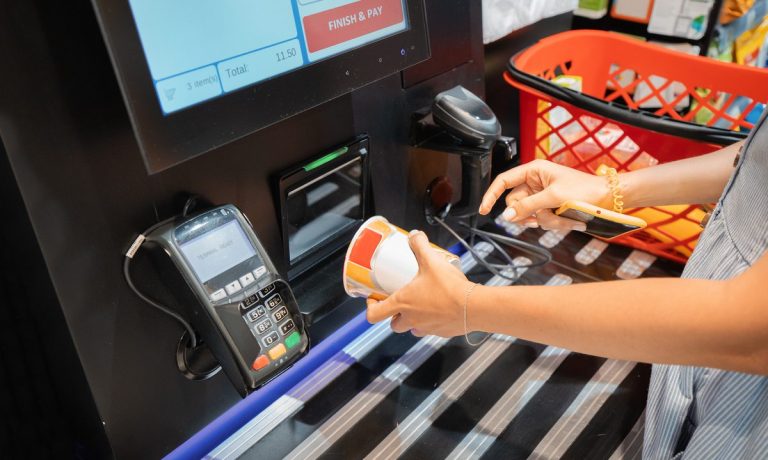Retailers Have Clear Opportunity to Ramp and Revamp the DIY Checkout Experience

Skipping lines always feels like a luxury. Whether skipping the line at Disney World or the local supermarket, the feeling of empowerment is the same. When it comes to supermarkets, consider how the self-checkout options allow consumers to breeze through what might otherwise involve 10 to 15 minutes of standing around, as well as a lot of touching and handling among strangers.
Indeed, the adoption and usage of self-service or DIY checkout — at all retail stores, not just grocers — is expected to explode, from $40 billion in consumer spending currently in the U.S. to $80 billion by 2026, a PYMNTS and Toshiba report found.
Read more: The New Retail Expectation
That doubling of capacity can’t happen soon enough, because as much as consumers want and love to cut the line, a separate survey showed nearly one-third of consumers (29%) currently think self-service is slower than traditional checkout, PYMNTS’ survey of over 2,000 U.S. consumers found. While the need for capacity is clear, the study also found a need for other revisions too, with 15% of respondents citing concerns about self-checkout stations making mistakes, with an additional 14% saying the current systems are hard to use.
Other pinch points and areas of improvement include price scanning and promotional problems, dealing with age-restricted or security-tagged items, as well as bagging and packaging.
To be sure, self-checkout is something big players like Walmart, Target and Home Depot have widely implemented already. But eCommerce giant Amazon is also actively trying to do away with cashiers in favor of processing payments via its touchless Just Go technology which it uses in some of its small format stores and offers to other retailers like Hudson’s and quick-service restaurants (QSRs) such as Starbucks.
Similarly, Amazon has also implemented palm scanning via biometric surveillance to grant people access to certain parts of a Starbucks store, like where the snacks are located. This technology is also used by Amazon in concert venues as a method of freestanding, contactless ticketing and payment and a means to confirm concert entry.
Closing the Gap Between Self-Checkout Supply and Demand
While far from perfect, self-service checkout enables many benefits that arguably outweigh the disadvantages, such as it being quicker for consumers and less burden on staff since it frees up the need for in-person cashiers. Most consumers — 66% — say self-service is faster than the alternative, according to PYMNTS.
Self-checkout, when it works as intended and doesn’t burden the consumer, is an easy get-in-get-out experience that empowers consumers by reducing friction when making a transaction.
Consumers generally tend to agree. There appears to be a big demand for self-checkout options. Most consumers — 80% — have an interest in trying out non-traditional checkout options such as self-service, per PYMNTS research. Those who haven’t yet tried it are reportedly ready to try it. Yet, only 1 in 3 consumers prefer self-service checkout to traditional checkout.
Nonetheless, a critical fact impacting data like this is that most consumers don’t have access to self-checkout options. A reported 41% of consumers say they don’t use self-checkout because it’s not an option for them where they shop, PYMNTS found.
Breaking down this stat further in terms of the generational divide, nearly half — 46% — of millennials (who tend to favor digital over non-digital) who used traditional checkout said this was because self-checkout wasn’t an option.
Snags = Innovation Opportunities
For all its consumer support and growing deployment, self-checkout still can prove cumbersome, but those pinch points and potholes of today are the solutions of tomorrow, and represent key opportunities for retailers to improve the user experience — especially in non-grocery environments.
The bottom line is since most consumers like and prefer to have a choice for self-checkout (in most circumstances) as a quicker and easier option, retailers must ensure that it remains quick, easy and available if they want to be consumers’ preferred choice.
As such, self-checkout demands both a ramp-up and a revamp. Perhaps there’s a way where the consumer can verify an age-restricted purchase without summoning staff, or better artificial intelligence can be leveraged to automatically determine what kind of produce or pants the consumer is buying. It’s innovations like these — however they end up panning out — that will lessen consumer burdens, omit steps, and drive higher self-checkout adoption rates and loyalty.
“Retailers that are executing self-service strategies aligned to their customers’ expectations are excelling,” PYMNTS and Toshiba found. “The onus is on retailers to effectively communicate the value of the self-service kiosk and to remove the customer experience barriers impeding its adoption.”
If that happens, that giddy feeling won’t have to be reserved for Disney World.